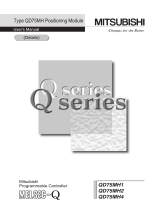
A - 15
3.3.2 Details of input signals (QD77MS
PLC CPU) ............................................................................ 3-19
3.3.3 Details of output signals (PLC CPU
QD77MS) .......................................................................... 3-21
3.4 Specifications of interfaces with external devices ................................................................................... 3-23
3.4.1 Electrical specifications of input signals ........................................................................................... 3-23
3.4.2 Signal layout for external input connection connector ..................................................................... 3-25
3.4.3 List of input signal details .................................................................................................................. 3-27
3.4.4 Interface internal circuit ..................................................................................................................... 3-30
3.5 External circuit design .............................................................................................................................. 3-34
4. Installation, Wiring and Maintenance of the Product 4- 1 to 4-20
4.1 Outline of installation, wiring and maintenance ....................................................................................... 4- 2
4.1.1 Installation, wiring and maintenance procedures ............................................................................. 4- 2
4.1.2 Names of each part ........................................................................................................................... 4- 3
4.1.3 Handling precautions ........................................................................................................................ 4- 5
4.2 Installation ................................................................................................................................................ 4- 7
4.2.1 Precautions for installation ................................................................................................................ 4- 7
4.3 Wiring ........................................................................................................................................................ 4- 8
4.3.1 Precautions for wiring ........................................................................................................................ 4- 8
4.4 Confirming the installation and wiring ...................................................................................................... 4-19
4.4.1 Items to confirm when installation and wiring are completed .......................................................... 4-19
4.5 Maintenance ............................................................................................................................................. 4-20
4.5.1 Precautions for maintenance ............................................................................................................ 4-20
4.5.2 Disposal instructions ......................................................................................................................... 4-20
5. Data Used for Positioning Control 5- 1 to 5-202
5.1 Types of data ............................................................................................................................................ 5- 2
5.1.1 Parameters and data required for control......................................................................................... 5- 2
5.1.2 Setting items for positioning parameters .......................................................................................... 5- 5
5.1.3 Setting items for OPR parameters .................................................................................................... 5- 7
5.1.4 Setting items for expansion parameters ........................................................................................... 5- 8
5.1.5 Setting items for servo parameters ................................................................................................... 5- 8
5.1.6 Setting items for positioning data ...................................................................................................... 5- 9
5.1.7 Setting items for block start data ...................................................................................................... 5-11
5.1.8 Setting items for condition data ........................................................................................................ 5-12
5.1.9 Types and roles of monitor data ....................................................................................................... 5-13
5.1.10 Types and roles of control data ...................................................................................................... 5-18
5.2 List of parameters .................................................................................................................................... 5-22
5.2.1 Basic parameters 1 ........................................................................................................................... 5-22
5.2.2 Basic parameters 2 ........................................................................................................................... 5-28
5.2.3 Detailed parameters 1 ....................................................................................................................... 5-29
5.2.4 Detailed parameters 2 ....................................................................................................................... 5-40
5.2.5 OPR basic parameters ...................................................................................................................... 5-52
5.2.6 OPR detailed parameters ................................................................................................................. 5-60
5.2.7 Expansion parameters ...................................................................................................................... 5-65
5.2.8 Servo parameters .............................................................................................................................. 5-70
5.3 List of positioning data ............................................................................................................................. 5-83
5.4 List of block start data .............................................................................................................................. 5-99
5.5 List of condition data .............................................................................................................................. 5-105
5.6 List of monitor data ................................................................................................................................. 5-116






















